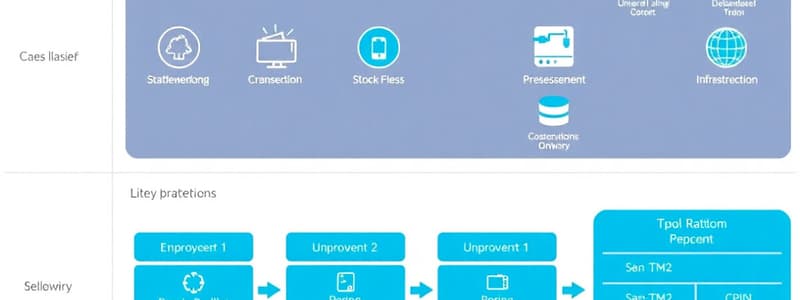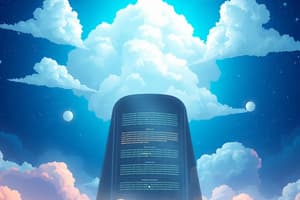Podcast
Questions and Answers
Which of the following is part of the recovery procedures in lifecycle management?
Which of the following is part of the recovery procedures in lifecycle management?
- Regular software updates
- Social media monitoring
- Restoring from failures (correct)
- Daily data entry
Proper data management involves ignoring corporate policies and regulations.
Proper data management involves ignoring corporate policies and regulations.
False (B)
Name one component of the vCloud Foundation infrastructure that has its own lifecycle management procedures.
Name one component of the vCloud Foundation infrastructure that has its own lifecycle management procedures.
vCenter Server Appliance
Automating routine tasks like patching and configuration increases _____ and reduces errors.
Automating routine tasks like patching and configuration increases _____ and reduces errors.
Match the following lifecycle aspects with their correct descriptions:
Match the following lifecycle aspects with their correct descriptions:
Which statement best describes compliance and auditing in lifecycle management?
Which statement best describes compliance and auditing in lifecycle management?
Documentation is unnecessary after initial deployment.
Documentation is unnecessary after initial deployment.
What is one benefit of automating tasks in the vCloud Foundation environment?
What is one benefit of automating tasks in the vCloud Foundation environment?
Each component of the vCloud Foundation infrastructure has its own unique set of _____ management procedures.
Each component of the vCloud Foundation infrastructure has its own unique set of _____ management procedures.
Which of the following is NOT a key component of lifecycle management in vCloud Foundation?
Which of the following is NOT a key component of lifecycle management in vCloud Foundation?
What is NOT included in the lifecycle management of vCloud Foundation 5.2?
What is NOT included in the lifecycle management of vCloud Foundation 5.2?
The decommissioning process begins with disabling and uninstalling components.
The decommissioning process begins with disabling and uninstalling components.
What are the two components involved in the initial deployment of vCloud Foundation 5.2?
What are the two components involved in the initial deployment of vCloud Foundation 5.2?
During ongoing maintenance, regular ____ and patch application are essential tasks.
During ongoing maintenance, regular ____ and patch application are essential tasks.
Match the vCloud Foundation lifecycle management phase with its description:
Match the vCloud Foundation lifecycle management phase with its description:
What is a primary focus during the ongoing maintenance of vCloud Foundation?
What is a primary focus during the ongoing maintenance of vCloud Foundation?
Security management in the lifecycle includes access controls and firewalls.
Security management in the lifecycle includes access controls and firewalls.
What are the tasks involved in troubleshooting and problem resolution in the lifecycle management?
What are the tasks involved in troubleshooting and problem resolution in the lifecycle management?
The process of applying periodic updates enhances ____ and feature capabilities.
The process of applying periodic updates enhances ____ and feature capabilities.
Which of the following best describes the term 'phased upgrades' in the context of vCloud Foundation?
Which of the following best describes the term 'phased upgrades' in the context of vCloud Foundation?
What is a crucial aspect of change management in lifecycle management?
What is a crucial aspect of change management in lifecycle management?
Detailed documentation is not necessary once the deployment is completed.
Detailed documentation is not necessary once the deployment is completed.
What is a key benefit of implementing automation in lifecycle management?
What is a key benefit of implementing automation in lifecycle management?
Regular ____ plans are essential for ensuring data protection.
Regular ____ plans are essential for ensuring data protection.
Match the following lifecycle management aspects with their descriptions:
Match the following lifecycle management aspects with their descriptions:
What is the main purpose of compliance monitoring?
What is the main purpose of compliance monitoring?
Backup and recovery processes are only needed during initial deployment.
Backup and recovery processes are only needed during initial deployment.
What is the purpose of implementing a disaster recovery strategy in lifecycle management?
What is the purpose of implementing a disaster recovery strategy in lifecycle management?
Applying security patches is part of maintaining ____ measures.
Applying security patches is part of maintaining ____ measures.
Which of the following is NOT a benefit of automation in lifecycle management?
Which of the following is NOT a benefit of automation in lifecycle management?
What is a critical aspect of the deployment phase in vCloud Foundation 5.2?
What is a critical aspect of the deployment phase in vCloud Foundation 5.2?
Regular upgrades are unnecessary as components in vCloud Foundation 5.2 remain compatible on their own.
Regular upgrades are unnecessary as components in vCloud Foundation 5.2 remain compatible on their own.
What are the key components requiring lifecycle management in vCloud Foundation 5.2?
What are the key components requiring lifecycle management in vCloud Foundation 5.2?
Monitoring tools and procedures are essential for identifying potential _____ and optimizing performance proactively.
Monitoring tools and procedures are essential for identifying potential _____ and optimizing performance proactively.
Match the lifecycle management components with their corresponding descriptions:
Match the lifecycle management components with their corresponding descriptions:
Which of the following activities is part of ongoing maintenance in vCloud Foundation 5.2?
Which of the following activities is part of ongoing maintenance in vCloud Foundation 5.2?
Configuration management involves only the initial setup of a system.
Configuration management involves only the initial setup of a system.
What is the purpose of decommissioning in lifecycle management?
What is the purpose of decommissioning in lifecycle management?
The process of upgrading components often involves performing a _____ upgrade for efficiency.
The process of upgrading components often involves performing a _____ upgrade for efficiency.
Match the lifecycle tasks to their definitions:
Match the lifecycle tasks to their definitions:
Flashcards
Disaster Recovery Plans
Disaster Recovery Plans
Procedures to quickly restore operations after disasters like natural disasters, cyberattacks, or hardware failures.
Business Continuity Plans
Business Continuity Plans
Strategies to ensure critical business functions continue during a disaster.
Data Backup Practices
Data Backup Practices
Procedures for storing and retrieving backups and archived data to prevent data loss.
Data Management Policies
Data Management Policies
Signup and view all the flashcards
Component-Specific Lifecycle
Component-Specific Lifecycle
Signup and view all the flashcards
Automation and Orchestration
Automation and Orchestration
Signup and view all the flashcards
vCloud Foundation Documentation
vCloud Foundation Documentation
Signup and view all the flashcards
Compliance and Auditing
Compliance and Auditing
Signup and view all the flashcards
vCenter Server Lifecycle
vCenter Server Lifecycle
Signup and view all the flashcards
NSX Manager Lifecycle
NSX Manager Lifecycle
Signup and view all the flashcards
vCloud Foundation Lifecycle Management
vCloud Foundation Lifecycle Management
Signup and view all the flashcards
Deployment and Configuration
Deployment and Configuration
Signup and view all the flashcards
Ongoing Maintenance
Ongoing Maintenance
Signup and view all the flashcards
Updates and Upgrades
Updates and Upgrades
Signup and view all the flashcards
Troubleshooting and Problem Resolution
Troubleshooting and Problem Resolution
Signup and view all the flashcards
Decommissioning
Decommissioning
Signup and view all the flashcards
Security Management
Security Management
Signup and view all the flashcards
What are some key tasks in ongoing maintenance?
What are some key tasks in ongoing maintenance?
Signup and view all the flashcards
What is the primary goal of updates and upgrades?
What is the primary goal of updates and upgrades?
Signup and view all the flashcards
What's the importance of decommissioning?
What's the importance of decommissioning?
Signup and view all the flashcards
Compliance Management
Compliance Management
Signup and view all the flashcards
Disaster Recovery (DR)
Disaster Recovery (DR)
Signup and view all the flashcards
Documentation
Documentation
Signup and view all the flashcards
Change Management
Change Management
Signup and view all the flashcards
Performance Tuning
Performance Tuning
Signup and view all the flashcards
Backup & Recovery
Backup & Recovery
Signup and view all the flashcards
Security Patches
Security Patches
Signup and view all the flashcards
Compliance Across Infrastructure
Compliance Across Infrastructure
Signup and view all the flashcards
Automated Upgrades
Automated Upgrades
Signup and view all the flashcards
vCloud Foundation 5.2 Lifecycle
vCloud Foundation 5.2 Lifecycle
Signup and view all the flashcards
Deployment in vCloud Foundation 5.2
Deployment in vCloud Foundation 5.2
Signup and view all the flashcards
Configuration Management in vCloud Foundation 5.2
Configuration Management in vCloud Foundation 5.2
Signup and view all the flashcards
Upgrades in vCloud Foundation 5.2
Upgrades in vCloud Foundation 5.2
Signup and view all the flashcards
Maintenance in vCloud Foundation 5.2
Maintenance in vCloud Foundation 5.2
Signup and view all the flashcards
Monitoring Tools in vCloud Foundation 5.2
Monitoring Tools in vCloud Foundation 5.2
Signup and view all the flashcards
Decommissioning in vCloud Foundation 5.2
Decommissioning in vCloud Foundation 5.2
Signup and view all the flashcards
Key Components of vCloud Foundation 5.2
Key Components of vCloud Foundation 5.2
Signup and view all the flashcards
Why is Configuration Management Important?
Why is Configuration Management Important?
Signup and view all the flashcards
What are Some Tasks During Decommissioning?
What are Some Tasks During Decommissioning?
Signup and view all the flashcards
Study Notes
Lifecycle Management for vCloud Foundation 5.2 Components
-
vCloud Foundation 5.2's lifecycle management encompasses the entire process, from deployment and configuration, to ongoing maintenance, updates, decommissioning, and security.
-
This process includes crucial components like vCenter Server instances, vCloud Director instances, storage, networking, security configurations, user accounts, and cloud services.
-
Deployment and Configuration: Initial setup involves installing, configuring networking, storage, and security settings according to policies. Deployment tools and procedures ensure consistency and reliability. This involves setting up vCenter Server Appliance, NSX Manager, and other required components.
-
Configuration Management: Maintaining optimal configuration is vital for performance and security. This involves defining roles, access controls, policies, and ensuring compliance with standards. Continuous monitoring and configuration changes are essential.
-
Upgrades: Planned upgrades, often rolling, are essential to ensure compatibility with security patches and best practices. Careful planning and testing are critical to avoid downtime.
-
Maintenance: Regular patching, security updates, and performance tuning are crucial for stability. Troubleshooting issues promptly is important.
-
Monitoring: Utilizing built-in monitoring tools and performance analysis is essential for identifying issues. Logging and analysis assists in optimization.
-
Decommissioning: Safe decommissioning follows organizational policy. This involves backups, data migration, and resource release, considering associated services and users. Disconnecting data centers from active use cases, disabling and uninstalling components, and documenting is part of this process.
-
Security: Effective security measures are crucial throughout the lifecycle. Maintaining access restrictions, applying security patches, and monitoring compliance guard sensitive data and configurations. Compliance across the entire infrastructure is critical.
-
Compliance: Adherence to industry standards, policies, and legal requirements is vital.
-
Automation and Orchestration: Automating tasks through tools significantly improves efficiency, minimizing errors and maximizing scalability, simplifying and speeding up tasks, including deployment and maintenance.
-
Disaster Recovery (DR): vCloud Foundation features aid in DR. Implementing a DR strategy ensures resilience against outages, creating backup and recovery plans.
-
Documentation: Detailed documentation, including deployment procedures, configurations, troubleshooting steps, and changes, supports continuous lifecycle management, aiding problem resolution.
-
Change Management: A structured approach to changes, including recording, approval, and implementation, minimizes operational risks.
-
Performance Tuning: Continuous monitoring and analysis of performance metrics ensure optimal performance and responsiveness. This includes tuning components to address slowdowns, CPU usage and memory issues.
-
Backup and Recovery: Regular backups and recovery plans are essential, protecting data during disasters; crucial for business continuity and availability.
-
Component-Specific Lifecycle Considerations: Component-specific procedures (like vCloud Director upgrades) are essential.
Studying That Suits You
Use AI to generate personalized quizzes and flashcards to suit your learning preferences.




